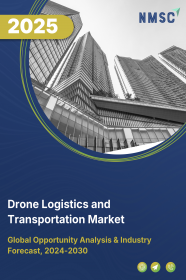
Norway Unmanned Ground Vehicle Market by Mode of Operation (Teleoperated and Autonomous), by Mode of Locomotion (Tracked, Wheeled, Legged, and Hybrid), by Size (Small, Medium, and Heavy), and by End-User Industry (Military & Defense, Agriculture, Mining, Law Enforcement, and Others) – Opportunity Analysis and Industry Forecast, 2024–2030
Industry: Aerospace & Defense | Publish Date: 18-Dec-2024 | No of Pages: 110 | No. of Tables: 78 | No. of Figures: 43 | Format: PDF | Report Code : AD2583
US Tariff Impact on Norway Unmanned Ground Vehicle Market
Trump Tariffs Are Reshaping Global Business
Norway Unmanned Ground Vehicle Market Overview:
The Norway Unmanned Ground Vehicle Market size was valued at USD 6.3 million in 2023, and is predicted to reach USD 12.5 million by 2030, with a CAGR of 10.2% from 2024 to 2030. In terms of volume, the market size was 80 units in 2023, and is projected to reach 235 units by 2030, with a CAGR of 16.7% from 2024 to 2030.
Unmanned ground vehicles (UGVs) are robotic systems engineered to operate autonomously on land without human intervention. They vary in size from small, agile units to larger, more robust models capable of traversing challenging terrain. While some UGVs are specialized for specific tasks such as pipeline inspection or hazardous material handling, others are adaptable for various applications. Equipped with sensors, cameras, and specialized equipment, these vehicles are capable of performing a wide range of tasks. UGVs are utilized for inspection, surveillance, mapping, and search and rescue operations. They are deployed in hazardous, repetitive, or contaminated environments, including urban, rural, and off-road settings.
UGVs find applications across military, search and rescue, agricultural, and transportation sectors. They operate autonomously, making decisions and navigating independently, or they can be remotely controlled by a human operator. One of the main advantages of UGVs is their ability to perform tasks in environments that are dangerous or inaccessible to humans, such as bomb disposal, hazardous material inspection, or search and rescue operations in collapsed buildings. They are also used for tasks that are repetitive or monotonous for humans, including surveillance and patrolling. Additionally, they play a role in agriculture and forestry, including crop monitoring, mapping, and inspection of irrigation systems.
Increasing Adoption of UGVs in Military and Defense Sector is Fueling the Norway Unmanned Ground Vehicle Market
The increasing integration of UGVs within military and defense entities is a significant driver behind the expansion of the unmanned ground vehicle (UGV) market. Their utilization in military endeavors is on the rise, and this trajectory is anticipated to persist as armed forces worldwide seek to diminish the reliance on deployed personnel in combat scenarios.
These vehicles fulfill diverse roles within the military and defense sphere, encompassing logistical support, bomb disposal, and surveillance duties. Operating within perilous environments, they undertake tasks of considerable risk. UGVs represent a safer and more efficient alternative to human involvement, thereby mitigating personnel hazards and enhancing operational efficacy across various domains.
Moreover, UGVs deployed in military and defense contexts afford enhanced adaptability and flexibility in dynamic settings, being remotely maneuverable and capable of functioning in hazardous conditions. Furthermore, their ability to operate continuously, devoid of the necessity for breaks, translates into heightened efficiency and productivity. Consequently, there exists a notable surge in the adoption of UGVs within military and defense applications, fueling market expansion.
Increasing Adoption of UGVs in Commercial & Industrial Applications is Driving Norway Unmanned Ground Vehicle Market
The rise in the utilization of Unmanned Ground Vehicles (UGVs) across commercial and industrial sectors serves as a significant catalyst for market expansion. Various industries, including agriculture, transportation, and logistics, are progressively integrating UGVs into their operations, a trend anticipated to persist as organizations pursue avenues for cost reduction and operational enhancement.
Within agriculture, UGVs find utility in tasks such as crop monitoring and pest management, thereby enhancing productivity while reducing reliance on manual labor. Similarly, in transportation and logistics, they fulfill roles such as package delivery, diminishing the need for human drivers. Leveraging UGVs in commercial and industrial contexts results in heightened productivity and cost-effectiveness, given their ability to operate continuously without breaks. Consequently, the proliferation of UGV adoption across these sectors is poised to propel further growth in the Norway unmanned ground vehicle market.
High Cost and Lack of Standardization of UGVs Restrain the Norway Unmanned Ground Vehicle Market Growth
The high costs involved in developing and deploying Unmanned Ground Vehicles (UGVs) pose a significant challenge to the market's growth. Typically, UGVs require substantial investments in both their development and production phases, dissuading certain companies or organizations from investing in them. These vehicles demand advanced technologies and specialized components, resulting in considerable expenses for production and maintenance.
Moreover, the intricate and time-consuming process of integrating UGVs into existing systems and workflows further escalates their overall cost. Additionally, the absence of standardization within the UGV market presents another barrier to its growth. Various UGV types and sizes are available, often customized for specific tasks or environments, complicating the selection process for companies and the creation of products compatible with diverse systems and applications by manufacturers.
The Convergence of AI and the Advancement of Intelligent UGVs Generate Numerous Opportunities
The implementation of artificial intelligence (AI) into Unmanned Ground Vehicles (UGVs) presents fresh prospects for the advancement of intelligent UGVs. Outfitted with cutting-edge technologies such as machine learning and natural language processing, these vehicles possess the capability to execute tasks autonomously and make decisions at an advanced level, thereby enhancing their precision and reliability and positioning them as valuable assets across diverse industries.
The advent of intelligent UGVs has the potential to transform multiple industries by augmenting efficiency, reducing reliance on human labor, and fortifying safety measures. Within the military and defense domain, intelligent UGVs fulfill roles in reconnaissance and surveillance, providing invaluable intelligence while mitigating risks to human personnel. Similarly, in agriculture, they contribute to activities such as precision farming, amplifying crop yields and minimizing resource consumption. Consequently, the progression of intelligent UGVs represents a significant market opportunity, poised to profoundly influence various sectors and foster fresh avenues for growth and innovation.
Competitive Landscape
Several market players operating in the Norway unmanned ground vehicle industry include ABB Ltd, Robot Solutions, Rheinmetall Nordic AS, HAVELSAN, Teledyne FLIR LLC, Kongsberg, Milrem, Robotnik Automation S.L., Textron Systems, Sherp. These market players are adopting various strategies to maintain their dominance in the market.
Norway Unmanned Ground Vehicle Market Key Segments
By Mode of Operation
-
Teleoperated
-
Autonomous
By Mode of Locomotion
-
Tracked
-
Wheeled
-
Legged
-
Hybrid
By Size
-
Small
-
Medium
-
Heavy
By End-User Industry
-
Military and Defense
-
Agriculture
-
Mining
-
Law Enforcement
-
Others
REPORT SCOPE AND SEGMENTATION:
|
Parameters |
Details |
|
Market Size in 2023 |
USD 6.3 Million |
|
Revenue Forecast in 2030 |
USD 12.5 Million |
|
Value Growth Rate |
CAGR of 10.2% from 2024 to 2030 |
|
Market Volume in 2023 |
80 Units |
|
Unit Forecast in 2030 |
235 Units |
|
Volume Growth Rate |
CAGR of 16.7% from 2024 to 2030 |
|
Analysis Period |
2023–2030 |
|
Base Year Considered |
2023 |
|
Forecast Period |
2024–2030 |
|
Market Size Estimation |
Million (USD) |
|
Growth Factors |
|
|
Companies Profiled |
10 |
|
Market Share |
Available for 10 companies |
|
Customization Scope |
Free customization (equivalent up to 80 working hours of analysts) after purchase. Addition or alteration to country, regional, and segment scope. |
|
Pricing and Purchase Options |
Avail customized purchase options to meet your exact research needs. |
KEY PLAYERS
-
ABB Ltd
-
Robot Solutions
-
Rheinmetall Nordic AS
-
HAVELSAN
-
Teledyne FLIR LLC
-
Kongsberg
-
Milrem
-
Robotnik Automation S.L.
-
Textron Systems
-
Sherp

















 Speak to Our Analyst
Speak to Our Analyst

















